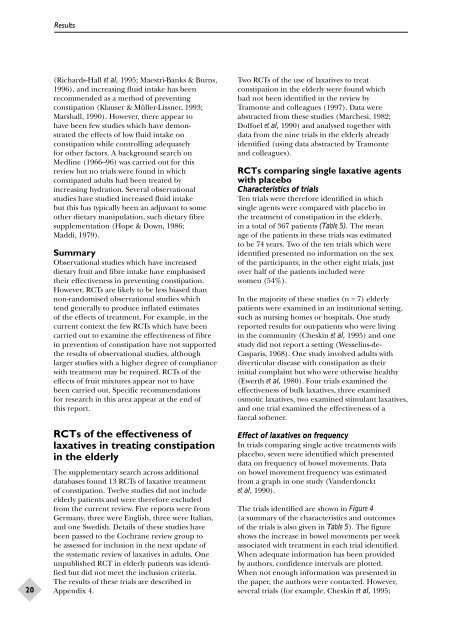Effectiveness of Laxatives in the Elderly - NIHR Health Technology ...
Effectiveness of Laxatives in the Elderly - NIHR Health Technology ...
Effectiveness of Laxatives in the Elderly - NIHR Health Technology ...
You also want an ePaper? Increase the reach of your titles
YUMPU automatically turns print PDFs into web optimized ePapers that Google loves.
20<br />
Results<br />
(Richards-Hall et al, 1995; Maestri-Banks & Burns,<br />
1996), and <strong>in</strong>creas<strong>in</strong>g fluid <strong>in</strong>take has been<br />
recommended as a method <strong>of</strong> prevent<strong>in</strong>g<br />
constipation (Klauser & Müller-Lissner, 1993;<br />
Marshall, 1990). However, <strong>the</strong>re appear to<br />
have been few studies which have demonstrated<br />
<strong>the</strong> effects <strong>of</strong> low fluid <strong>in</strong>take on<br />
constipation while controll<strong>in</strong>g adequately<br />
for o<strong>the</strong>r factors. A background search on<br />
Medl<strong>in</strong>e (1966–96) was carried out for this<br />
review but no trials were found <strong>in</strong> which<br />
constipated adults had been treated by<br />
<strong>in</strong>creas<strong>in</strong>g hydration. Several observational<br />
studies have studied <strong>in</strong>creased fluid <strong>in</strong>take<br />
but this has typically been an adjuvant to some<br />
o<strong>the</strong>r dietary manipulation, such dietary fibre<br />
supplementation (Hope & Down, 1986;<br />
Maddi, 1979).<br />
Summary<br />
Observational studies which have <strong>in</strong>creased<br />
dietary fruit and fibre <strong>in</strong>take have emphasised<br />
<strong>the</strong>ir effectiveness <strong>in</strong> prevent<strong>in</strong>g constipation.<br />
However, RCTs are likely to be less biased than<br />
non-randomised observational studies which<br />
tend generally to produce <strong>in</strong>flated estimates<br />
<strong>of</strong> <strong>the</strong> effects <strong>of</strong> treatment. For example, <strong>in</strong> <strong>the</strong><br />
current context <strong>the</strong> few RCTs which have been<br />
carried out to exam<strong>in</strong>e <strong>the</strong> effectiveness <strong>of</strong> fibre<br />
<strong>in</strong> prevention <strong>of</strong> constipation have not supported<br />
<strong>the</strong> results <strong>of</strong> observational studies, although<br />
larger studies with a higher degree <strong>of</strong> compliance<br />
with treatment may be required. RCTs <strong>of</strong> <strong>the</strong><br />
effects <strong>of</strong> fruit mixtures appear not to have<br />
been carried out. Specific recommendations<br />
for research <strong>in</strong> this area appear at <strong>the</strong> end <strong>of</strong><br />
this report.<br />
RCTs <strong>of</strong> <strong>the</strong> effectiveness <strong>of</strong><br />
laxatives <strong>in</strong> treat<strong>in</strong>g constipation<br />
<strong>in</strong> <strong>the</strong> elderly<br />
The supplementary search across additional<br />
databases found 13 RCTs <strong>of</strong> laxative treatment<br />
<strong>of</strong> constipation. Twelve studies did not <strong>in</strong>clude<br />
elderly patients and were <strong>the</strong>refore excluded<br />
from <strong>the</strong> current review. Five reports were from<br />
Germany, three were English, three were Italian,<br />
and one Swedish. Details <strong>of</strong> <strong>the</strong>se studies have<br />
been passed to <strong>the</strong> Cochrane review group to<br />
be assessed for <strong>in</strong>clusion <strong>in</strong> <strong>the</strong> next update <strong>of</strong><br />
<strong>the</strong> systematic review <strong>of</strong> laxatives <strong>in</strong> adults. One<br />
unpublished RCT <strong>in</strong> elderly patients was identified<br />
but did not meet <strong>the</strong> <strong>in</strong>clusion criteria.<br />
The results <strong>of</strong> <strong>the</strong>se trials are described <strong>in</strong><br />
Appendix 4.<br />
Two RCTs <strong>of</strong> <strong>the</strong> use <strong>of</strong> laxatives to treat<br />
constipation <strong>in</strong> <strong>the</strong> elderly were found which<br />
had not been identified <strong>in</strong> <strong>the</strong> review by<br />
Tramonte and colleagues (1997). Data were<br />
abstracted from <strong>the</strong>se studies (Marchesi, 1982;<br />
D<strong>of</strong>foel et al, 1990) and analysed toge<strong>the</strong>r with<br />
data from <strong>the</strong> n<strong>in</strong>e trials <strong>in</strong> <strong>the</strong> elderly already<br />
identified (us<strong>in</strong>g data abstracted by Tramonte<br />
and colleagues).<br />
RCTs compar<strong>in</strong>g s<strong>in</strong>gle laxative agents<br />
with placebo<br />
Characteristics <strong>of</strong> trials<br />
Ten trials were <strong>the</strong>refore identified <strong>in</strong> which<br />
s<strong>in</strong>gle agents were compared with placebo <strong>in</strong><br />
<strong>the</strong> treatment <strong>of</strong> constipation <strong>in</strong> <strong>the</strong> elderly,<br />
<strong>in</strong> a total <strong>of</strong> 367 patients (Table 5). The mean<br />
age <strong>of</strong> <strong>the</strong> patients <strong>in</strong> <strong>the</strong>se trials was estimated<br />
to be 74 years. Two <strong>of</strong> <strong>the</strong> ten trials which were<br />
identified presented no <strong>in</strong>formation on <strong>the</strong> sex<br />
<strong>of</strong> <strong>the</strong> participants; <strong>in</strong> <strong>the</strong> o<strong>the</strong>r eight trials, just<br />
over half <strong>of</strong> <strong>the</strong> patients <strong>in</strong>cluded were<br />
women (54%).<br />
In <strong>the</strong> majority <strong>of</strong> <strong>the</strong>se studies (n = 7) elderly<br />
patients were exam<strong>in</strong>ed <strong>in</strong> an <strong>in</strong>stitutional sett<strong>in</strong>g,<br />
such as nurs<strong>in</strong>g homes or hospitals. One study<br />
reported results for out-patients who were liv<strong>in</strong>g<br />
<strong>in</strong> <strong>the</strong> community (Chesk<strong>in</strong> et al, 1995) and one<br />
study did not report a sett<strong>in</strong>g (Wesselius-de-<br />
Casparis, 1968). One study <strong>in</strong>volved adults with<br />
diverticular disease with constipation as <strong>the</strong>ir<br />
<strong>in</strong>itial compla<strong>in</strong>t but who were o<strong>the</strong>rwise healthy<br />
(Ewerth et al, 1980). Four trials exam<strong>in</strong>ed <strong>the</strong><br />
effectiveness <strong>of</strong> bulk laxatives, three exam<strong>in</strong>ed<br />
osmotic laxatives, two exam<strong>in</strong>ed stimulant laxatives,<br />
and one trial exam<strong>in</strong>ed <strong>the</strong> effectiveness <strong>of</strong> a<br />
faecal s<strong>of</strong>tener.<br />
Effect <strong>of</strong> laxatives on frequency<br />
In trials compar<strong>in</strong>g s<strong>in</strong>gle active treatments with<br />
placebo, seven were identified which presented<br />
data on frequency <strong>of</strong> bowel movements. Data<br />
on bowel movement frequency was estimated<br />
from a graph <strong>in</strong> one study (Vanderdonckt<br />
et al, 1990).<br />
The trials identified are shown <strong>in</strong> Figure 4<br />
(a summary <strong>of</strong> <strong>the</strong> characteristics and outcomes<br />
<strong>of</strong> <strong>the</strong> trials is also given <strong>in</strong> Table 5). The figure<br />
shows <strong>the</strong> <strong>in</strong>crease <strong>in</strong> bowel movements per week<br />
associated with treatment <strong>in</strong> each trial identified.<br />
When adequate <strong>in</strong>formation has been provided<br />
by authors, confidence <strong>in</strong>tervals are plotted.<br />
When not enough <strong>in</strong>formation was presented <strong>in</strong><br />
<strong>the</strong> paper, <strong>the</strong> authors were contacted. However,<br />
several trials (for example, Chesk<strong>in</strong> et al, 1995;
















